NIKON TRIMBLE NT0001 Bluetooth module User Manual Nivo manual 1
NIKON-TRIMBLE CO., LTD. Bluetooth module Nivo manual 1
Contents
Host 2 user manual 1 of 3
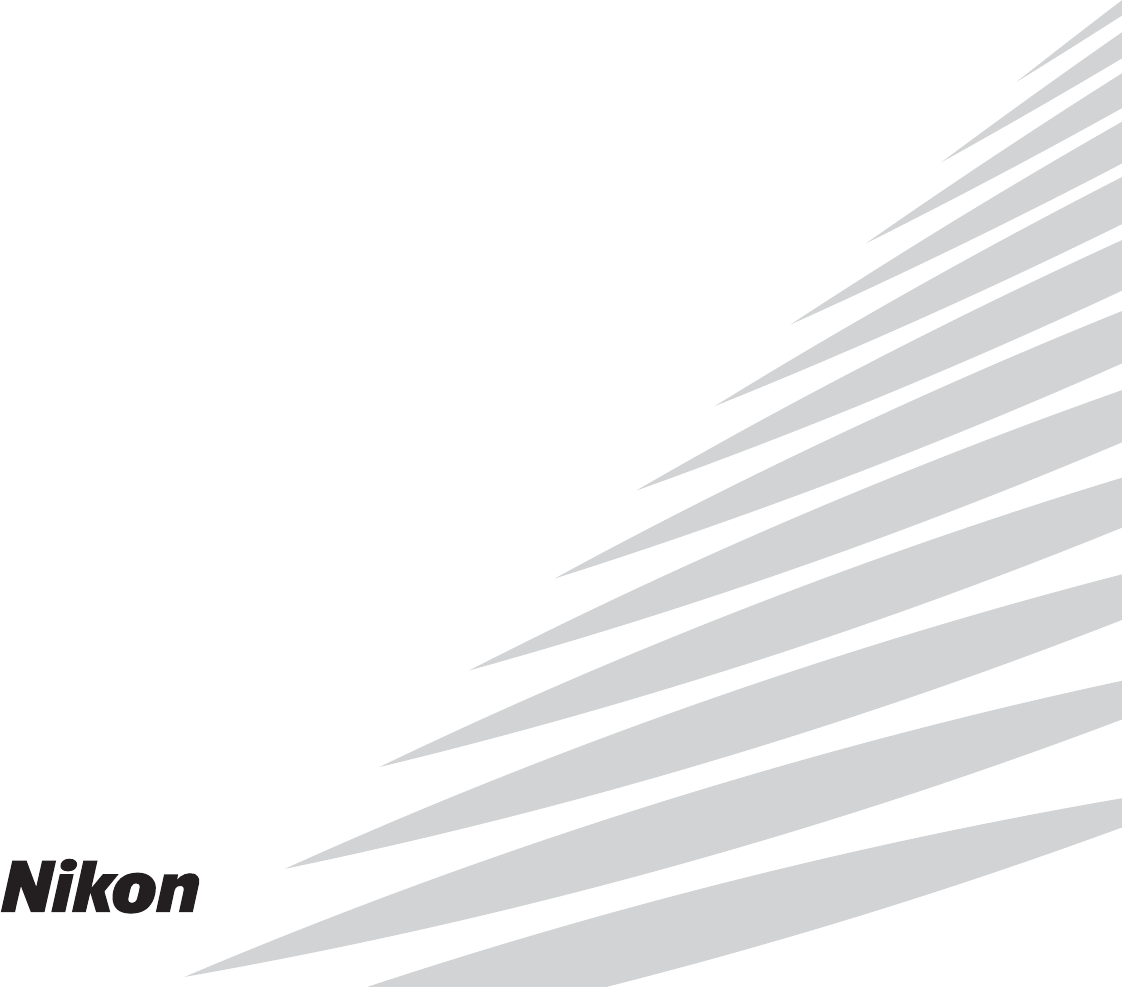
www.trimble.com
Total Station Nivo Series
Nivo3.M and Nivo5.M
Instruction Manual
Version A 1.0.0
Part Number C231E
February 2009

Contact Information
Trimble Navigation Limited
Engineering and Construction Division
5475 Kellenburger Road
Dayton, Ohio 45424-1099
USA
800-538-7800 (toll free in USA)
+1-937-245-5600 Phone
+1-937-233-9004 Fax
www.trimble.com
Legal Notices
Copyright and Trademarks
© 2007-2008, Nikon-Trimble Co. Limited. All rights reserved.
All trademarks are the property of their respective owners.
It is prohibited to alter this manual in part or whole without express
permission.
The contents of this manual are subject to change without notice.
Although every effort has been made to ensure the accuracy of this
manual, please contact your dealer if you find anything in it that is
incorrect or unclear.
Release Notice
This is the February 2009 (Revision A) release of the Total Station Nivo
Series Instruction Manual. It applies to software release version 1.0.0
for the Total Station Nivo series.
Manufacturer
Nikon-Trimble Co., Ltd.
Technoport Mituiseimei Bldg.
16-2, Minamikamata 2-chome, Ota-ku
Tokyo 144-0035 Japan
Notices
USA
FCC 15B Class B satisfied.
This equipment has been tested and found to comply with the limits for
a Class B digital device, pursuant to Part 15 of the FCC Rules. These
limits are designed to provide reasonable protection against harmful
interference in a residential installation. This equipment generates, uses
and can radiate radio frequency energy and, if not installed and used in
accordance with the instructions, may cause harmful interference to
radio communications. However, there is no guarantee that interference
will not occur in a particular installation.
If this equipment does cause harmful interference to radio or television
reception, which can be determined by turning the equipment off and
on, the user is encouraged to try to correct the interference by one or
more of the following measures:
– Reorient or relocate the receiving antenna.
– Increase the separation between the equipment and receiver.
– Connect the equipment into an outlet on a circuit different from that
to which the receiver is connected.
– Consult the dealer or an experienced radio/TV technician for help.
CWarning – This equipment has been certified to
comply with the limits for a Class B personal
computer and peripherals, pursuant to Subpart B of
Part 15 of FCC Rules. Only peripherals (computer
input/output devices, terminals, printers, etc.)
certified to comply with the Class B limits may be
attached to this equipment. Operation with
non-certified personal computer and/or peripherals
is likely to result in interference to radio and TV
reception. The connection of a non-shielded
equipment interface cable to this equipment will
invalidate the FCC Certification of this device and
may cause interference levels which exceed the
limits established by the FCC for this equipment.
You are cautioned that changes or modifications not
expressly approved by the party responsible for
compliance could void your authority to operate the
equipment.
European Union
EU EMC Directive satisfied.
Authorized Representative in Europe
Trimble GmbH
Am Prime Parc 11
65479 Raunheim, Germany
Canada
This Class B digital apparatus meets all requirements of the Canadian
Interference-Causing Equipment Regulations.
Cet appareil numérique de la Class B respecte toutes les exigences du
Règlement sur le matériel brouilleur du Canada.
Taiwan
Battery Recycling
Requirements
The product contains a removable battery.
Taiwanese regulations require that waste batteries
are recycled.
Notice to Our European Union Customers
For product recycling instructions and more information,
please go to:
www.trimble.com/environment/summary.html
Recycling in Europe
To recycle Trimble WEEE,
call: +31 497 53 2430,
and ask for the “WEEE associate,”
or mail a request for recycling instructions to:
Trimble Europe BV
c/o Menlo Worldwide Logistics
Meerheide 45
5521 DZ Eersel, NL
For optional Bluetooth unit
USA
FCC Part 15 Subpart/RSS-210, OET bulletin 65 supplement C satisfied
CCaution – Any changes or modifications not
expressly approved by the party responsible for
compliance could void the user's authority to
operate the equipment.
NOTE: This equipment has been tested and found to comply with the
limits for a Class B digital device, pursuant to part 15 of the FCC Rules.
These limits are designed to provide reasonable protection against
harmful interference in a residential installation. This equipment
generates, uses and can radiate radio frequency energy and, if not
installed and used in accordance with the instructions, may cause
harmful interference to radio communications. However, there is no
guarantee that interference will not occur in a particular installation. If
this equipment does cause harmful interference to radio or television
reception, which can be determined by turning the equipment off and
on, the user is encouraged to try to correct the interference by one or
more of the following measures:
– Reorient or relocate the receiving antenna.
– Increase the separation between the equipment and receiver.
– Connect the equipment into an outlet on a circuit different from that
to which the receiver is connected.
– Consult the dealer or an experienced radio/TV technician for help.
Canada
RSS-210 Low Power Device
Operation is subject to the following two conditions: (1) This device
may not cause interference, and (2) this device must accept any
interference, including interference that may cause undesired operation
of the device.
European Union countries, Iceland, Norway, Liechtenstein,
Turkey, Swiss
EN300 328v1.7.1, EN50360 satisfied
Hereby, Nikon-Trimble Co., Ltd., declares that this instrument is in
compliance with the essential requirements and other relevant
provisions of Directive 1999/5/EC.
Declaration of Conformity available at http://www.nikon-trimble.com/
RF exposure compliance
1) To comply with FCC/IC RF exposure compliance requirements, a
separation distance of at least 20 cm must be maintained between
the antenna of this device and all persons.
2) This transmitter must not be co-located or operating in conjunction
with any other antenna or transmitter.
Total Station Nivo Series Instruction Manual iii
Safety 1
In this chapter:
QIntroduction
QWarnings and Cautions
QLaser Safety

Safety
iv Total Station Nivo Series Instruction Manual
Introduction
For your safety, read this instruction manual carefully and thoroughly before using
the Total Station Nivo series. Although Nikon products are designed for maximum
safety, using them incorrectly or disregarding the instructions can cause personal
injury or property damage.
You should also read the documentation for any other equipment that you use with a
Nivo series instrument.
Note – Always keep the manual near the instrument for easy reference.
Warnings and Cautions
The following conventions are used to indicate safety instructions:
CWARNING – Warnings alert you to situations that could cause death or serious injury.
CCAUTION – Cautions alert you to situations that could cause injury or property damage.
Always read and follow the instructions carefully.
Warnings
Before using the instrument, read the following warnings and follow the instructions
that they provide:
CWARNING – Never look at the sun through the telescope. If you do, you may damage or lose
your eyesight.
CWARNING – Nivo series instruments are not designed to be explosion-proof. Do not use the
instrument in coal mines, in areas contaminated with coal dust, or near other flammable
substances.
CWARNING – Never disassemble, modify, or repair the instrument yourself. If you do, you may
receive electric shocks or burns, or the instrument may catch fire. You may also impair the
accuracy of the instrument.
CWARNING – Use only the battery charger and AC adapter that are supplied with the
instrument. Do not use any other charger or you may cause the battery pack to catch fire or
rupture.

Total Station Nivo Series Instruction Manual v
Safety
CWARNING – Do not cover the battery charger and AC adapter while the battery pack is being
recharged. The charger must be able to dissipate heat adequately. Coverings such as blankets
or clothing can cause the charger to overheat.
CWARNING – Avoid recharging the battery pack in humid or dusty places, in direct sunlight, or
near heat sources. Do not recharge the battery pack when it is wet. If you do, you may receive
electric shocks or burns, or the battery pack may overheat or catch fire.
CWARNING – Although the battery pack has an auto-reset circuit breaker, you should take care
not to short circuit the contacts. Short circuits can cause the battery pack to catch fire or burn
you.
CWARNING – Never burn or heat the battery. Doing so may cause the battery to leak or rupture.
A leaking or ruptured battery can cause serious injury.
CWARNING – Before storing the battery pack or battery charger, cover the contact points with
insulation tape. If you do not cover the contact points, the battery pack or charger may short
circuit, causing fire, burns, or damage to the instrument.
CWARNING – The battery is not itself waterproof. Do not get the battery wet when it is removed
from the instrument. If water seeps into the battery, it may cause a fire or burns.
Cautions
Before using the instrument, read the following cautions and follow the instructions
that they provide:
CCAUTION – Use of controls, adjustments, or performance of procedures other than those
specified herein may result in hazardous radiation exposure.
CCAUTION – The tops of the tripod ferrules are very sharp. When handling or carrying the
tripod, take care to avoid injuring yourself on the ferrules.
CCAUTION – Before carrying the tripod or the instrument in the carrying case, check the
shoulder strap and its clasp. If the strap is damaged or the clasp is not securely fastened, the
carrying case may fall, causing personal injury or instrument damage.
CCAUTION – Before setting up the tripod, make sure that no-one’s hands or feet are underneath
it. When the legs of the tripod are being driven into the ground, they could pierce hands or feet.

Safety
vi Total Station Nivo Series Instruction Manual
CCAUTION – After mounting the instrument on the tripod, securely fasten the thumb screws on
the tripod legs. If the thumb screws are not securely fastened, the tripod may collapse, causing
personal injury or instrument damage.
CCAUTION – After mounting the instrument on the tripod, securely fasten the clamp screw on
the tripod. If the clamp screw is not securely fastened, the instrument may fall off the tripod,
causing personal injury or instrument damage.
CCAUTION – Securely fasten the tribrach clamp knob. If the knob is not securely fastened, the
tribrach may come loose or fall off when you lift the instrument, causing personal injury or
instrument damage.
CCAUTION – Do not stack objects on the plastic carrying case, or use it as a stool. The plastic
carrying case is unstable and its surface is slippery. Stacking or sitting on the plastic carrying
case may cause personal injury or instrument damage.
CCAUTION – The system in the instrument may stop functioning in order to avoid any errors in
measurement when the instrument detects strong electromagnetic wave(s). If this is the case,
turn off the instrument and remove the source of the electromagnetic wave(s). Then turn on the
instrument to resume the work.
Rechargeable Lithium-ion (Li-ion) batteries
CWARNING – Do not damage the rechargeable Lithium-ion battery. A damaged battery can
cause an explosion or fire, and can result in personal injury and/or property damage.
To prevent injury or damage:
– Do not use or charge the battery if it appears to be damaged. Signs of damage include, but
are not limited to, discoloration, warping, and leaking battery fluid.
– Do not expose the battery to fire, high temperature, or direct sunlight.
– Do not immerse the battery in water.
– Do not use or store the battery inside a vehicle during hot weather.
– Do not drop or puncture the battery.
– Do not open the battery or short-circuit its contacts.
CWARNING – Avoid contact with the rechargeable Lithium-ion battery if it appears to be leaking.
Battery fluid is corrosive, and contact with it can result in personal injury and/or property
damage.
To prevent injury or damage:
– If the battery leaks, avoid contact with the battery fluid.
– If battery fluid gets into your eyes, immediately rinse your eyes with clean water and seek
medical attention. Do not rub your eyes!
– If battery fluid gets onto your skin or clothing, immediately use clean water to wash off the
battery fluid.

Total Station Nivo Series Instruction Manual vii
Safety
CWARNING – Charge and use the rechargeable Lithium-ion battery only in strict accordance
with the instructions. Charging or using the battery in unauthorized equipment can cause an
explosion or fire, and can result in personal injury and/or equipment damage.
To prevent injury or damage:
– Do not charge or use the battery if it appears to be damaged or leaking.
– Charge the Lithium-ion battery only in a product that is specified to charge it. Be sure to
follow all instructions that are provided with the battery charger.
– Discontinue charging a battery that gives off extreme heat or a burning odor.
– Use the battery only in equipment that is specified to use it.
– Use the battery only for its intended use and according to the instructions in the product
documentation.
Laser Safety
The Nivo series is a Class 2 laser instrument.
Nivo Series is a Class 2 Laser Product in accordance with: IEC60825-1, Am2 (2001):
“Safety of Laser Products”
Precautions: To counteract hazards, it is essential for all users to pay careful attention
to the safety precautions and control measures specified in the standard IEC60825-1
(2001-08) resp. EN60825-1:1994 + A11:1996 + A2:2001, within the hazard
distance *); particularly on to “User’s Guide”.
CWARNING – Only qualified and trained persons should be assigned to install, adjust and
operate the laser equipment.
CWARNING – Precautions should be taken to ensure that persons do not look directly, with or
without an optical instrument, into the beam.
CWARNING – Laser beam path should be located well above or below eye level wherever
practicable.
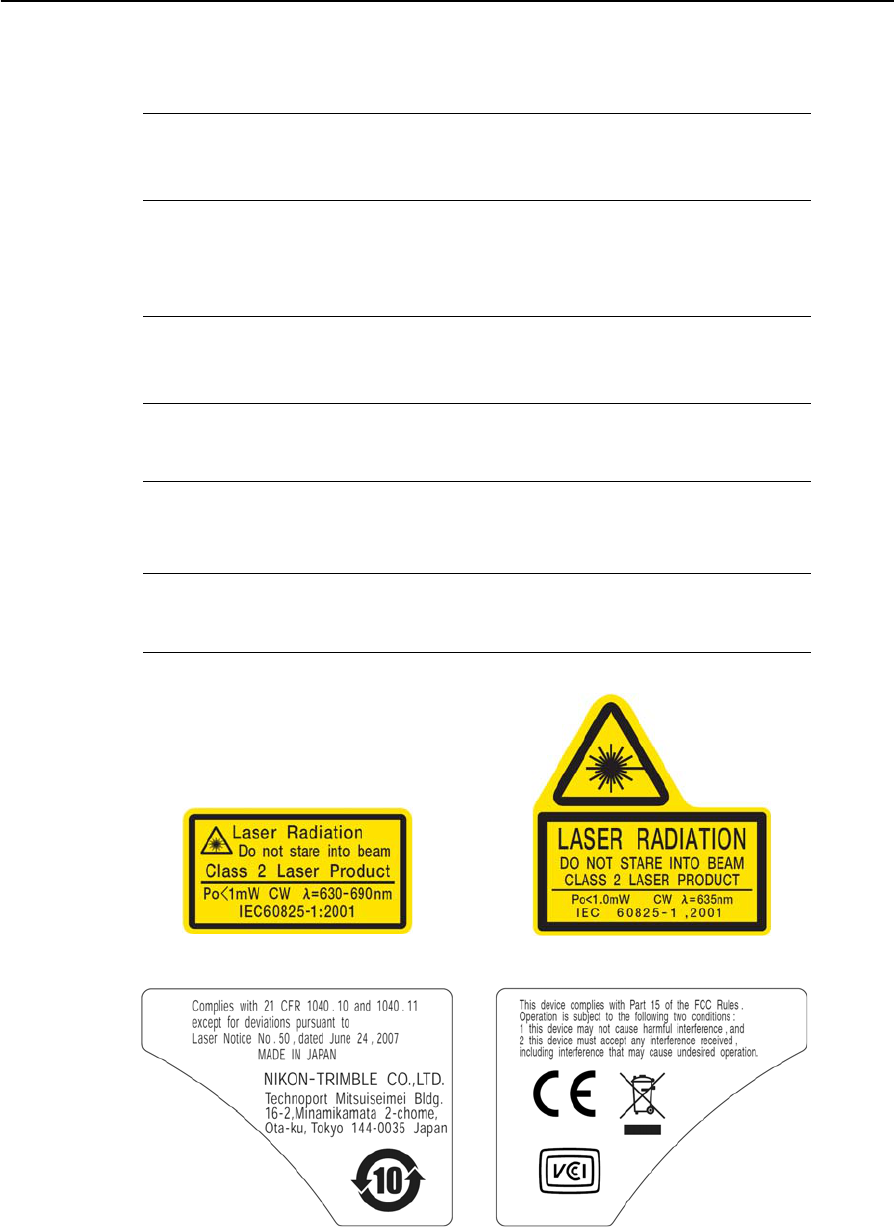
Safety
viii Total Station Nivo Series Instruction Manual
Table 1.1 Specifications for laser emission
Laser pointer
Wave length 630-680 nm
Output power CW Po ≤ 1 mW
Disatance meter
Wave length 850-890 nm
Output power Pulse Po ≤ 6.4 W
Pulse width < 5 ns
Laser plummet (Option)
Wave length 635 nm
Output power CW Po < 1.0 mW
Table 1.2 Conforming standards
E.U. EN60825-1/Am.2 : 2001 (IEC60825-1/Am.2 : 2001)
Laser Pointer: Class 2
Distance Meter: Class 1
Laser plummet: Class 2 (Option)
USA FDA21CFR Part 1040 Sec.1040.10 and 1040.11
(except for deviations pursuant to Laser Notice No.50, dated June
24, 2007)
Laser pointer Laser plummet (Option)
Total Station Nivo Series Instruction Manual ix
Contents
Safety . . . . . . . . . . . . . . . . . . . . . . . . . . . . . . . . . . . . . . iii
Introduction . . . . . . . . . . . . . . . . . . . . . . . . . . . . . . . . . . . . . . . . . iv
Warnings and Cautions . . . . . . . . . . . . . . . . . . . . . . . . . . . . . . . . . . . . iv
Warnings . . . . . . . . . . . . . . . . . . . . . . . . . . . . . . . . . . iv
Cautions . . . . . . . . . . . . . . . . . . . . . . . . . . . . . . . . . . v
Rechargeable Lithium-ion (Li-ion) batteries . . . . . . . . . . . . . . . . . . . . . . . . . . vi
Laser Safety. . . . . . . . . . . . . . . . . . . . . . . . . . . . . . . . . . . . . . . . . vii
1 Introduction. . . . . . . . . . . . . . . . . . . . . . . . . . . . . . . . . . . . 1
Welcome . . . . . . . . . . . . . . . . . . . . . . . . . . . . . . . . . . . . . . . . . . 2
Parts of the Instrument . . . . . . . . . . . . . . . . . . . . . . . . . . . . . . . . . . . . 3
Maintenance . . . . . . . . . . . . . . . . . . . . . . . . . . . . . . . . . . . . . . . . 5
2 Preparation . . . . . . . . . . . . . . . . . . . . . . . . . . . . . . . . . . . . 7
Unpacking and Packing the Instrument . . . . . . . . . . . . . . . . . . . . . . . . . . . . 8
Unpacking . . . . . . . . . . . . . . . . . . . . . . . . . . . . . . . . . 8
Packing . . . . . . . . . . . . . . . . . . . . . . . . . . . . . . . . . . . 8
Charging the Battery Pack . . . . . . . . . . . . . . . . . . . . . . . . . . . . . . . . . . 8
Detaching and Re-Attaching the Battery Pack. . . . . . . . . . . . . . . . . . . . . . . . . . 12
Setting Up the Tripod . . . . . . . . . . . . . . . . . . . . . . . . . . . . . . . . . . . . 13
Centering . . . . . . . . . . . . . . . . . . . . . . . . . . . . . . . . . . . . . . . . . . 13
Centering using the optical plummet . . . . . . . . . . . . . . . . . . . . . . .13
Centering using the laser plummet . . . . . . . . . . . . . . . . . . . . . . . .14
Centering using a plumb bob . . . . . . . . . . . . . . . . . . . . . . . . . . 15
Leveling . . . . . . . . . . . . . . . . . . . . . . . . . . . . . . . . . . . . . . . . . . 15
Sighting . . . . . . . . . . . . . . . . . . . . . . . . . . . . . . . . . . . . . . . . . . 16
Setting the Measurement Mode and Preparing the Target . . . . . . . . . . . . . . . . . . . . 17
Measurement with a prism . . . . . . . . . . . . . . . . . . . . . . . . . . .17
Measurement in Reflectorless mode . . . . . . . . . . . . . . . . . . . . . . . . . . . . . . 18
Preparing the Reflector Sheet . . . . . . . . . . . . . . . . . . . . . . . . . . . . . . . . . 19
Setting Up the Prism Reflector . . . . . . . . . . . . . . . . . . . . . . . . . . . . . . . . 20
Adjusting the height of the tribrach adapter . . . . . . . . . . . . . . . . . . . . .21
Changing the direction of the prism . . . . . . . . . . . . . . . . . . . . . . .21
Setting the prism constant . . . . . . . . . . . . . . . . . . . . . . . . . . .21
Setting the position of the target plate . . . . . . . . . . . . . . . . . . . . . . . 22
3 Getting Started . . . . . . . . . . . . . . . . . . . . . . . . . . . . . . . . . . 23
Turning the Instrument On and Off . . . . . . . . . . . . . . . . . . . . . . . . . . . . . . 24
Turning on the instrument . . . . . . . . . . . . . . . . . . . . . . . . . . . 24
Turning off the instrument . . . . . . . . . . . . . . . . . . . . . . . . . . . 24
Changing Regional Configuration Pre-sets . . . . . . . . . . . . . . . . . . . . . . . . . . . 25
Display and Key Functions . . . . . . . . . . . . . . . . . . . . . . . . . . . . . . . . . . 26
Status bar . . . . . . . . . . . . . . . . . . . . . . . . . . . . . . . . . .28
LCD backlight, Laser pointer, Beep sound and Contrast adjustment . . . . . . . . . . .30
[DSP] key . . . . . . . . . . . . . . . . . . . . . . . . . . . . . . . . . .31
[MODE] key. . . . . . . . . . . . . . . . . . . . . . . . . . . . . . . . . .32
[COD] key . . . . . . . . . . . . . . . . . . . . . . . . . . . . . . . . . . 33
[HOT] key . . . . . . . . . . . . . . . . . . . . . . . . . . . . . . . . . .34

Contents
x Total Station Nivo Series Instruction Manual
Bubble indicator . . . . . . . . . . . . . . . . . . . . . . . . . . . . . . .36
Laser plummet . . . . . . . . . . . . . . . . . . . . . . . . . . . . . . . .36
[USR] keys . . . . . . . . . . . . . . . . . . . . . . . . . . . . . . . . . .37
[DAT] key. . . . . . . . . . . . . . . . . . . . . . . . . . . . . . . . . . . 38
List Display . . . . . . . . . . . . . . . . . . . . . . . . . . . . . . . . . . . . . . . . . 39
Inputting Data . . . . . . . . . . . . . . . . . . . . . . . . . . . . . . . . . . . . . . . . 39
Entering a point name or number . . . . . . . . . . . . . . . . . . . . . . . . .39
Entering a code . . . . . . . . . . . . . . . . . . . . . . . . . . . . . . .43
Advanced feature: Searching for a code by using the first character . . . . . 44
Entering values in feet and inches . . . . . . . . . . . . . . . . . . . . . . . .45
Jobs . . . . . . . . . . . . . . . . . . . . . . . . . . . . . . . . . . . . . . . . . . . . 45
Creating a new job . . . . . . . . . . . . . . . . . . . . . . . . . . . . . .46
Measuring Distances . . . . . . . . . . . . . . . . . . . . . . . . . . . . . . . . . . . . . 47
Sighting a prism reflector . . . . . . . . . . . . . . . . . . . . . . . . . . . 47
Measuring distances. . . . . . . . . . . . . . . . . . . . . . . . . . . . . . 47
Measurement settings . . . . . . . . . . . . . . . . . . . . . . . . . . . . . 48
4 Applications . . . . . . . . . . . . . . . . . . . . . . . . . . . . . . . . . . . 51
HA Reset and Angle Operations . . . . . . . . . . . . . . . . . . . . . . . . . . . . . . . . 52
Setting the horizontal angle to 0 . . . . . . . . . . . . . . . . . . . . . . . . . 52
Entering the horizontal angle . . . . . . . . . . . . . . . . . . . . . . . . . .52
Recording a foresight point after repeat angle measurement . . . . . . . . . . . . . . 52
Horizontal angle hold . . . . . . . . . . . . . . . . . . . . . . . . . . . . . 53
Station Setup . . . . . . . . . . . . . . . . . . . . . . . . . . . . . . . . . . . . . . . . 53
Setting up a station with known coordinates or azimuth. . . . . . . . . . . . . . . .54
Setting up a station using multiple point resection . . . . . . . . . . . . . . . . . . 57
Advanced feature: Viewing and deleting a measurement in resection . . . . .59
Setting up the station quickly without coordinates . . . . . . . . . . . . . . . . . .60
Determining station elevation . . . . . . . . . . . . . . . . . . . . . . . . . .60
Checking and resetting the backsight direction . . . . . . . . . . . . . . . . . . .61
Two-point resection along a known line . . . . . . . . . . . . . . . . . . . . . .62
Stakeout . . . . . . . . . . . . . . . . . . . . . . . . . . . . . . . . . . . . . . . . . . 64
Specifying the stakeout point by angle and distance . . . . . . . . . . . . . . . . .65
Specifying the stakeout point by coordinates . . . . . . . . . . . . . . . . . . . . 66
Advanced feature: Specifying a stakeout list by range input . . . . . . . . 68
DivLine S-O . . . . . . . . . . . . . . . . . . . . . . . . . . . . . . . . .68
RefLine S-O . . . . . . . . . . . . . . . . . . . . . . . . . . . . . . . . .69
Program Key . . . . . . . . . . . . . . . . . . . . . . . . . . . . . . . . . . . . . . . . 71
Measuring distance and offset values along a specified line . . . . . . . . . . . . . .71
Measuring distance and offset values on the arc-curve . . . . . . . . . . . . . . . .73
Remote distance measurement. . . . . . . . . . . . . . . . . . . . . . . . . .75
Measuring remote elevation . . . . . . . . . . . . . . . . . . . . . . . . . . .77
Measuring distance and offset values on the vertical plane . . . . . . . . . . . . . . .78
Measuring distance and offset values on the slope . . . . . . . . . . . . . . . . . .80
Recording Measurement Data. . . . . . . . . . . . . . . . . . . . . . . . . . . . . . . . . 81
Recording data from any observation screen . . . . . . . . . . . . . . . . . . . . 81
Outputting data to the COM port . . . . . . . . . . . . . . . . . . . . . . . . .82
Measuring Offsets . . . . . . . . . . . . . . . . . . . . . . . . . . . . . . . . . . . . . . 83

Total Station Nivo Series Instruction Manual xi
Contents
Measuring taped offsets . . . . . . . . . . . . . . . . . . . . . . . . . . . . 83
Measuring angle offsets . . . . . . . . . . . . . . . . . . . . . . . . . . . . 84
Two-prism pole . . . . . . . . . . . . . . . . . . . . . . . . . . . . . . .85
Extending a line by horizontal angle offset . . . . . . . . . . . . . . . . . . . . .86
Entering a horizontal distance after an angle-only shot . . . . . . . . . . . . . . . . 87
Calculating a corner point . . . . . . . . . . . . . . . . . . . . . . . . . . . 88
Measuring circle offsets . . . . . . . . . . . . . . . . . . . . . . . . . . . . 89
Extending the slope distance. . . . . . . . . . . . . . . . . . . . . . . . . . . 90
5 Menu Key. . . . . . . . . . . . . . . . . . . . . . . . . . . . . . . . . . . . . 91
Introduction . . . . . . . . . . . . . . . . . . . . . . . . . . . . . . . . . . . . . . . . . 92
Job Manager . . . . . . . . . . . . . . . . . . . . . . . . . . . . . . . . . . . . . . . . 92
Opening an existing job . . . . . . . . . . . . . . . . . . . . . . . . . . . .92
Creating a new job . . . . . . . . . . . . . . . . . . . . . . . . . . . . . .93
Deleting a job . . . . . . . . . . . . . . . . . . . . . . . . . . . . . . . . 94
Setting the control job . . . . . . . . . . . . . . . . . . . . . . . . . . . . . 94
Displaying job Information . . . . . . . . . . . . . . . . . . . . . . . . . . .95
Cogo . . . . . . . . . . . . . . . . . . . . . . . . . . . . . . . . . . . . . . . . . . . . 96
Calculating angle and distance between two coordinates . . . . . . . . . . . . . . .96
Calculating and manually inputting coordinates . . . . . . . . . . . . . . . . . . .98
Calculating area and perimeter . . . . . . . . . . . . . . . . . . . . . . . . 100
Advanced feature: Entering a range of points . . . . . . . . . . . . . 101
Calculating coordinates from line and offset . . . . . . . . . . . . . . . . . . . 102
Calculating coordinates using intersection functions . . . . . . . . . . . . . . . . 103
Advanced feature: Entering angle and distance offsets . . . . . . . . . 107
Settings. . . . . . . . . . . . . . . . . . . . . . . . . . . . . . . . . . . . . . . . . . 108
Angle . . . . . . . . . . . . . . . . . . . . . . . . . . . . . . . . . . 108
Distance . . . . . . . . . . . . . . . . . . . . . . . . . . . . . . . . . 109
Coordinate . . . . . . . . . . . . . . . . . . . . . . . . . . . . . . . . 110
Power saving. . . . . . . . . . . . . . . . . . . . . . . . . . . . . . . . 110
Communications . . . . . . . . . . . . . . . . . . . . . . . . . . . . . . 111
Stakeout. . . . . . . . . . . . . . . . . . . . . . . . . . . . . . . . . . 111
Unit . . . . . . . . . . . . . . . . . . . . . . . . . . . . . . . . . . . 111
Recording. . . . . . . . . . . . . . . . . . . . . . . . . . . . . . . . . 112
Others settings . . . . . . . . . . . . . . . . . . . . . . . . . . . . . . . 112
Data . . . . . . . . . . . . . . . . . . . . . . . . . . . . . . . . . . . . . . . . . . . 114
Viewing records . . . . . . . . . . . . . . . . . . . . . . . . . . . . . . 114
Deleting records . . . . . . . . . . . . . . . . . . . . . . . . . . . . . . 117
Editing records. . . . . . . . . . . . . . . . . . . . . . . . . . . . . . . 119
Searching records . . . . . . . . . . . . . . . . . . . . . . . . . . . . . . 122
Entering coordinates . . . . . . . . . . . . . . . . . . . . . . . . . . . . 124
Point name list and code list . . . . . . . . . . . . . . . . . . . . . . . . . . 124
Communication . . . . . . . . . . . . . . . . . . . . . . . . . . . . . . . . . . . . . . 128
Downloading data. . . . . . . . . . . . . . . . . . . . . . . . . . . . . . 128
Uploading coordinate data . . . . . . . . . . . . . . . . . . . . . . . . . . 129
Advanced feature: Editing the data order for upload . . . . . . . . . . 130
Uploading a point name list or code list . . . . . . . . . . . . . . . . . . . . . 131
1sec-Keys . . . . . . . . . . . . . . . . . . . . . . . . . . . . . . . . . . . . . . . . . 131

Contents
xii Total Station Nivo Series Instruction Manual
[MSR] key settings . . . . . . . . . . . . . . . . . . . . . . . . . . . . . . 132
[DSP] key settings . . . . . . . . . . . . . . . . . . . . . . . . . . . . . . 132
[USR] key settings . . . . . . . . . . . . . . . . . . . . . . . . . . . . . . 132
[S-O] key settings . . . . . . . . . . . . . . . . . . . . . . . . . . . . . . 133
[DAT] key settings . . . . . . . . . . . . . . . . . . . . . . . . . . . . . . 133
Calibration . . . . . . . . . . . . . . . . . . . . . . . . . . . . . . . . . . . . . . . . 134
Time . . . . . . . . . . . . . . . . . . . . . . . . . . . . . . . . . . . . . . . . . . . 134
6 Checking and Adjustment . . . . . . . . . . . . . . . . . . . . . . . . . . . . 135
Adjusting the Electronic Level . . . . . . . . . . . . . . . . . . . . . . . . . . . . . . . 136
Checking and Adjusting the Circular Level. . . . . . . . . . . . . . . . . . . . . . . . . . 136
Checking and Adjusting the Optical/Laser Plummet. . . . . . . . . . . . . . . . . . . . . . 136
Zero Point Errors of Vertical Scale and Horizontal Angle Corrections . . . . . . . . . . . . . . 137
Checking . . . . . . . . . . . . . . . . . . . . . . . . . . . . . . . . . 137
Adjusting . . . . . . . . . . . . . . . . . . . . . . . . . . . . . . . . . 138
Checking the Instrument Constant . . . . . . . . . . . . . . . . . . . . . . . . . . . . . . 139
Checking the Laser Pointer . . . . . . . . . . . . . . . . . . . . . . . . . . . . . . . . . 140
7 Specifications . . . . . . . . . . . . . . . . . . . . . . . . . . . . . . . . . 141
Main Body . . . . . . . . . . . . . . . . . . . . . . . . . . . . . . . . . . . . . . . . 142
Telescope . . . . . . . . . . . . . . . . . . . . . . . . . . . . . . . . . 142
Measurement range . . . . . . . . . . . . . . . . . . . . . . . . . . . . . 142
Distance precision . . . . . . . . . . . . . . . . . . . . . . . . . . . . . 142
Measurement intervals . . . . . . . . . . . . . . . . . . . . . . . . . . . . 143
Angle measurement . . . . . . . . . . . . . . . . . . . . . . . . . . . . . 143
Tilt sensor. . . . . . . . . . . . . . . . . . . . . . . . . . . . . . . . . 143
Tangent screw . . . . . . . . . . . . . . . . . . . . . . . . . . . . . . . 143
Tribrach. . . . . . . . . . . . . . . . . . . . . . . . . . . . . . . . . . 143
Level . . . . . . . . . . . . . . . . . . . . . . . . . . . . . . . . . . 144
Optical plummet . . . . . . . . . . . . . . . . . . . . . . . . . . . . . . 144
Optional laser plummet. . . . . . . . . . . . . . . . . . . . . . . . . . . . 144
Display and keypad . . . . . . . . . . . . . . . . . . . . . . . . . . . . . 144
Connections in the base of instrument . . . . . . . . . . . . . . . . . . . . . . 144
Battery pack . . . . . . . . . . . . . . . . . . . . . . . . . . . . . . . . 145
Environmental performance . . . . . . . . . . . . . . . . . . . . . . . . . . 145
Dimensions . . . . . . . . . . . . . . . . . . . . . . . . . . . . . . . . 145
Weight . . . . . . . . . . . . . . . . . . . . . . . . . . . . . . . . . . 145
Environmental protection . . . . . . . . . . . . . . . . . . . . . . . . . . 145
Standard Components . . . . . . . . . . . . . . . . . . . . . . . . . . . . . . . . . . . 146
External Device Connector . . . . . . . . . . . . . . . . . . . . . . . . . . . . . . . . . 146
8 System Diagrams . . . . . . . . . . . . . . . . . . . . . . . . . . . . . . . . 149
System Components . . . . . . . . . . . . . . . . . . . . . . . . . . . . . . . . . . . . 150
9 Communications . . . . . . . . . . . . . . . . . . . . . . . . . . . . . . . . 153
Uploading Coordinate Data . . . . . . . . . . . . . . . . . . . . . . . . . . . . . . . . . 154
Settings . . . . . . . . . . . . . . . . . . . . . . . . . . . . . . . . . . 154
Record format . . . . . . . . . . . . . . . . . . . . . . . . . . . . . . . 154
Uploading Point Lists and Code Lists . . . . . . . . . . . . . . . . . . . . . . . . . . . . 156
Settings . . . . . . . . . . . . . . . . . . . . . . . . . . . . . . . . . . 156

Total Station Nivo Series Instruction Manual xiii
Contents
File format . . . . . . . . . . . . . . . . . . . . . . . . . . . . . . . . 156
Data example . . . . . . . . . . . . . . . . . . . . . . . . . . . . . . . 157
Downloading Data . . . . . . . . . . . . . . . . . . . . . . . . . . . . . . . . . . . . . 158
Settings . . . . . . . . . . . . . . . . . . . . . . . . . . . . . . . . . . 158
Nikon raw record formats . . . . . . . . . . . . . . . . . . . . . . . . . . 158
SDR2x and SDR33 record formats . . . . . . . . . . . . . . . . . . . . . . . 161
Data examples . . . . . . . . . . . . . . . . . . . . . . . . . . . . . . . 165
10 Error Messages . . . . . . . . . . . . . . . . . . . . . . . . . . . . . . . . . 169
Cogo . . . . . . . . . . . . . . . . . . . . . . . . . . . . . . . . . . . . . . . . . . . 170
Communications . . . . . . . . . . . . . . . . . . . . . . . . . . . . . . . . . . . . . 170
Data . . . . . . . . . . . . . . . . . . . . . . . . . . . . . . . . . . . . . . . . . . . 171
Job Manager . . . . . . . . . . . . . . . . . . . . . . . . . . . . . . . . . . . . . . . 172
Programs . . . . . . . . . . . . . . . . . . . . . . . . . . . . . . . . . . . . . . . . . 172
Recording Data . . . . . . . . . . . . . . . . . . . . . . . . . . . . . . . . . . . . . . 173
Searching . . . . . . . . . . . . . . . . . . . . . . . . . . . . . . . . . . . . . . . . . 174
Settings. . . . . . . . . . . . . . . . . . . . . . . . . . . . . . . . . . . . . . . . . . 174
Stakeout . . . . . . . . . . . . . . . . . . . . . . . . . . . . . . . . . . . . . . . . . 174
Station Setup . . . . . . . . . . . . . . . . . . . . . . . . . . . . . . . . . . . . . . . 175
System Error . . . . . . . . . . . . . . . . . . . . . . . . . . . . . . . . . . . . . . . 176

Contents
xiv Total Station Nivo Series Instruction Manual

CHAPTER
1
Total Station Nivo Series Instruction Manual 1
Introduction 1
In this chapter:
QWelcome
QParts of the Instrument
QMaintenance

1 Introduction
2 Total Station Nivo Series Instruction Manual
Welcome
Thank you for purchasing this Nikon product.
This instruction manual was written for the users of Total Station Nivo series
instruments. Before you operate a Nivo series instrument, read this manual carefully.
In particular, pay attention to the warnings and cautions that appear in the Safety
section at the front of the manual. Before you begin, you should also read the
maintenance instructions. For more information, see Maintenance, page 5.
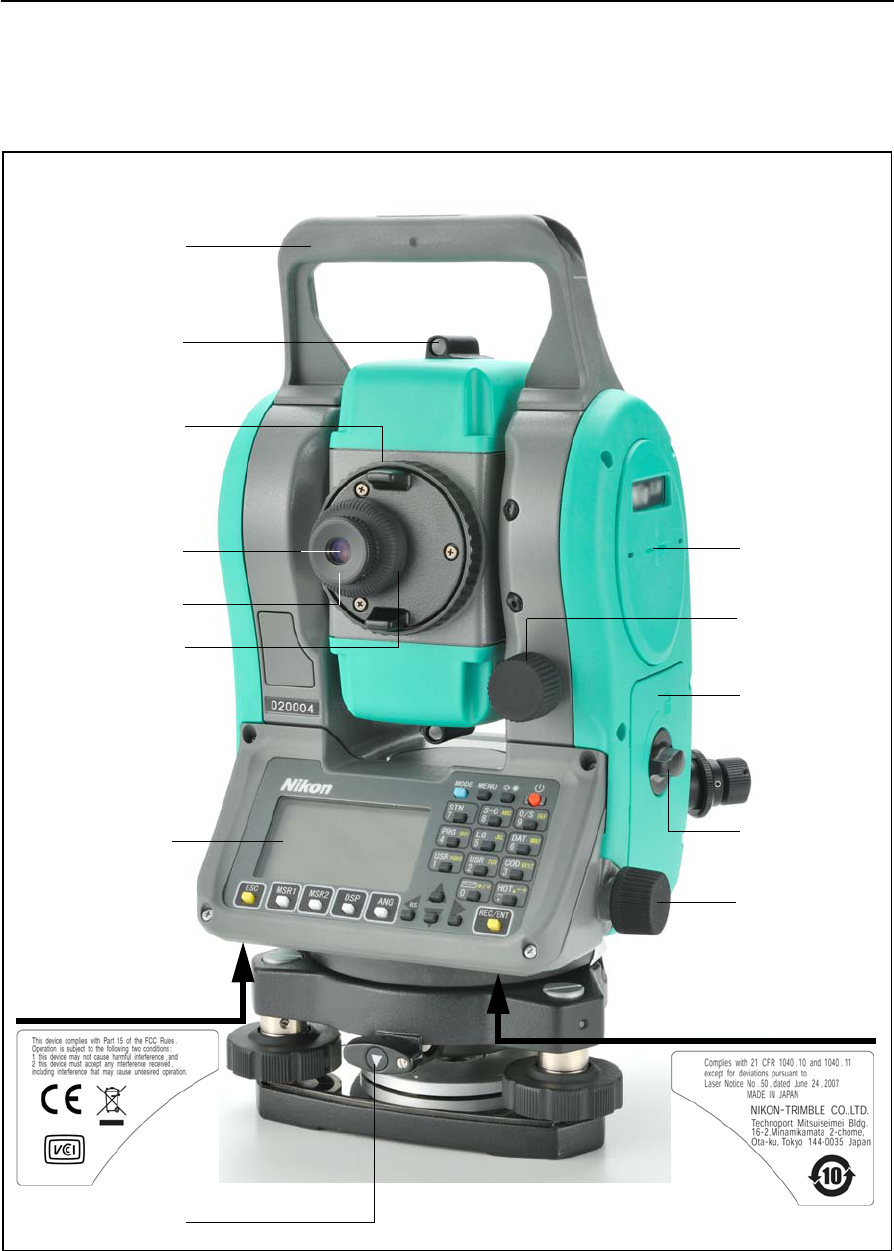
Total Station Nivo Series Instruction Manual 3
Introduction 1
Parts of the Instrument
Figure 1.1 and Figure 1.2 show the main parts of the Nivo series instrument.
Figure 1.1 Total Station Nivo series – Face-1
Te l e s c op e
Te l e s c op e
Diopter ring
Face-1 display /
Horizontal axis
Vertical tangent
Battery box
Upper plate
screw
tangent screw
focusing ring
eyepiece
keyboard
Carrying handle
Optical sight
(Finder)
Reticle plate cover
The Laser Safety Label shown
below is attached to the
underside of the keyboard
Tribrach clamp knob
Battery box
release knob
indication mark
The label shown below is
attached to the underside
of the keyboard.
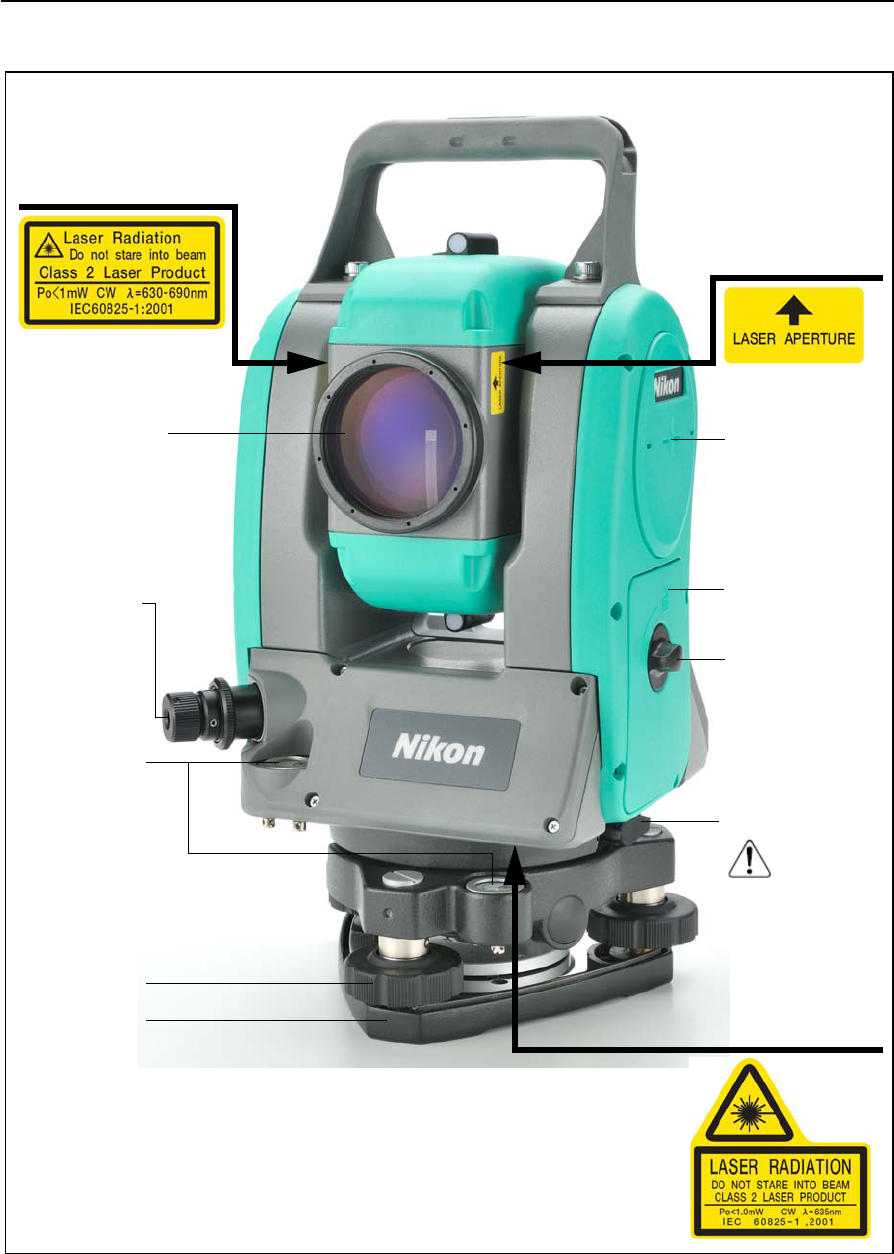
1 Introduction
4 Total Station Nivo Series Instruction Manual
Figure 1.2 Total Station Nivo series – Face-2
Horizontal axis
indication mark
Objective
Battery box
The Laser Safety label
shown below is attached
to the telescope.
LASER LIGHT IS
EMITTED FROM
THIS PART.
Data output /
external power
input connector
Input voltage
shall be
Circular level
Battery box
The Laser Safety
label shown below
is attached to
.
the telescope.
release knob
Leveling screw
Tribrach
The Laser Safety label
shown below will be
attached here (underside)
when the optional laser
plummet is used.
Optical or
optional laser
plummet
(This picture
shows
the optical
plummet.)
4.5-5.2 V DC

Total Station Nivo Series Instruction Manual 5
Introduction 1
Maintenance
Before using the instrument, read and follow the following maintenance instructions:
•Do not leave the instrument in direct sunlight or in a closed vehicle for
prolonged periods. Overheating the instrument may reduce its efficiency.
•If the Nivo series instrument has been used in wet conditions, immediately
wipe off any moisture and dry the instrument completely before returning the
instrument to the carrying case. The instrument contains sensitive electronic
assemblies which have been well protected against dust and moisture.
However, if dust or moisture gets into the instrument, severe damage could
result.
•Sudden changes in temperature may cloud the lenses and drastically reduce the
measurable distance, or cause an electrical system failure. If there has been a
sudden change in temperature, leave the instrument in a closed carrying case in
a warm location until the temperature of the instrument returns to room
temperature.
•Do not store the Nivo series instrument in hot or humid locations. In particular,
you must store the battery pack in a dry location at a temperature of less than
30 °C (86 °F). High temperature or excessive humidity can cause mold to grow
on the lenses. It can also cause the electronic assemblies to deteriorate, and so
lead to instrument failure.
•Store the battery pack with the battery discharged.
•When storing the instrument in areas subject to extremely low temperatures,
leave the carrying case open.
•When adjusting the leveling screws, stay as close as possible to the center of
each screw’s range. The center is indicated by a line on the screw.
•If the tribrach will not be used for an extended period, lock down the tribrach
clamp knob and tighten its safety screw.
•Do not use organic solvents (such as ether or paint thinner) to clean the
non-metallic parts of the instrument (such as the keyboard) or the painted or
printed surfaces. Doing so could result in discoloration of the surface, or in
peeling of printed characters. Clean these parts only with a soft cloth or a
tissue, lightly moistened with water or a mild detergent.
•To clean the optical lenses, lightly wipe them with a soft cloth or a lens tissue
that is moistened with alcohol.
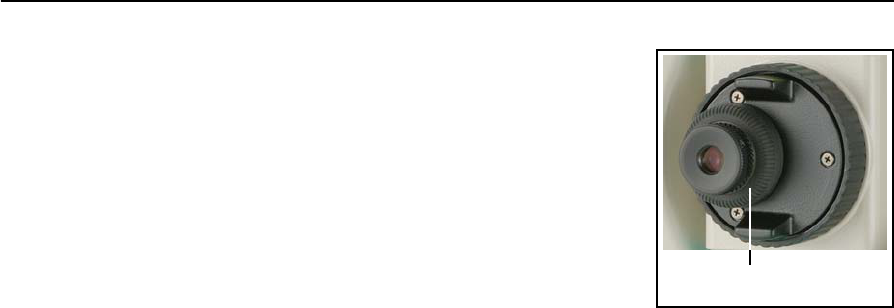
1 Introduction
6 Total Station Nivo Series Instruction Manual
•The reticle plate cover has been correctly
mounted. Do not release it or subject it to
excessive force to make it watertight.
•Before attaching the battery pack, check that the
contact surfaces on the battery and instrument are
clean.
•Securely press the cap that covers the data
output/external power input connector terminal.
The instrument is not watertight if the cap is not
attached securely, or when the data output/external
power input connector is used.
•The carrying case is designed to be watertight, but you should not leave it
exposed to rain for an extended period. If exposure to rain is unavoidable,
make sure that the carrying case is placed with the Nikon nameplate facing
upward.
•The battery pack contains a Lithium-ion battery. When disposing of the battery
pack, follow the laws or rules of your municipal waste system.
•The instrument can be damaged by static electricity from the human body
discharged through the data output/external power input connector. Before
handling the instrument, touch any other conductive material once to remove
static electricity.
•Be careful not to pinch your finger between the telescope and trunnion of the
instrument.
Reticle plate cover